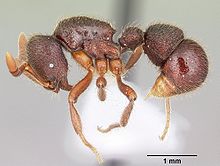| Proceratium google | |
|---|---|

| |
| Proceratium google worker, holotype specimen | |
| Scientific classification | |
| Domain: | Eukaryota |
| Kingdom: | Animalia |
| Phylum: | Arthropoda |
| Class: | Insecta |
| Order: | Hymenoptera |
| Family: | Formicidae |
| Genus: | Proceratium |
| Species: | P. google
|
| Binomial name | |
| Proceratium google Fisher, 2005
| |
Proceratium google, also known as the Google ant, was discovered in Madagascar by Brian L. Fisher, Associate Curator of Entomology at the California Academy of Sciences. The ant has an oddly shaped abdomen, adapted for hunting its exclusive meal of spider eggs.[1]
Fisher named the ant after the search engine company Google Inc., as a tribute to the usefulness of Google Earth in his research.[2][1] He wrote:[2]
Named in recognition of the support from the Google company. I hope that Google will continue applying its talent to serve data relevant to the biodiversity community, conservation planners, and the general public. By creating a “Zoogle,” Google could help achieve free and democratic access to taxonomic and biodiversity data on species. P. google is also suspected to be a specialist egg predator of spiders, which is also why this ant is aptly named after Google— for the ability to hunt down obscure prey. The specific name is an arbitrary combination, to be treated as a noun in apposition.
References[edit]
- ^ a b Fisher, Brian L. (30 September 2005). "Ants unearthed with Google Earth". Google Official Blog. Retrieved 30 September 2005.
- ^ a b Fisher, B. L. 2005. A new species of Discothyrea Roger from Mauritius and a new species of Proceratium Roger from Madagascar (Hymenoptera: Formicidae). Proceedings of the California Academy of Sciences (4)56:657-667. [2005-12-30] PDF 131285
- Antweb (2005). Species: Proceratium google. Retrieved September 30, 2005.
- California Academy of Sciences (2005). ACADEMY SCIENTIST MAPS WORLD'S ANTS WITH GOOGLE EARTH. Retrieved September 30, 2005.
Well, that’s interesting to know that Psilotum nudum are known as whisk ferns. Psilotum nudum is the commoner species of the two. While the P. flaccidum is a rare species and is found in the tropical islands. Both the species are usually epiphytic in habit and grow upon tree ferns. These species may also be terrestrial and grow in humus or in the crevices of the rocks.
View the detailed Guide of Psilotum nudum: Detailed Study Of Psilotum Nudum (Whisk Fern), Classification, Anatomy, Reproduction